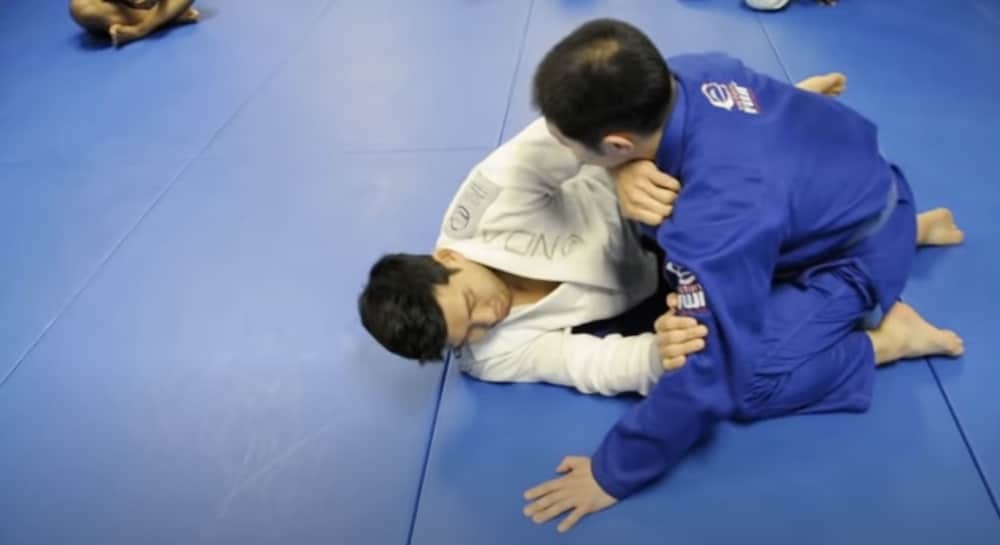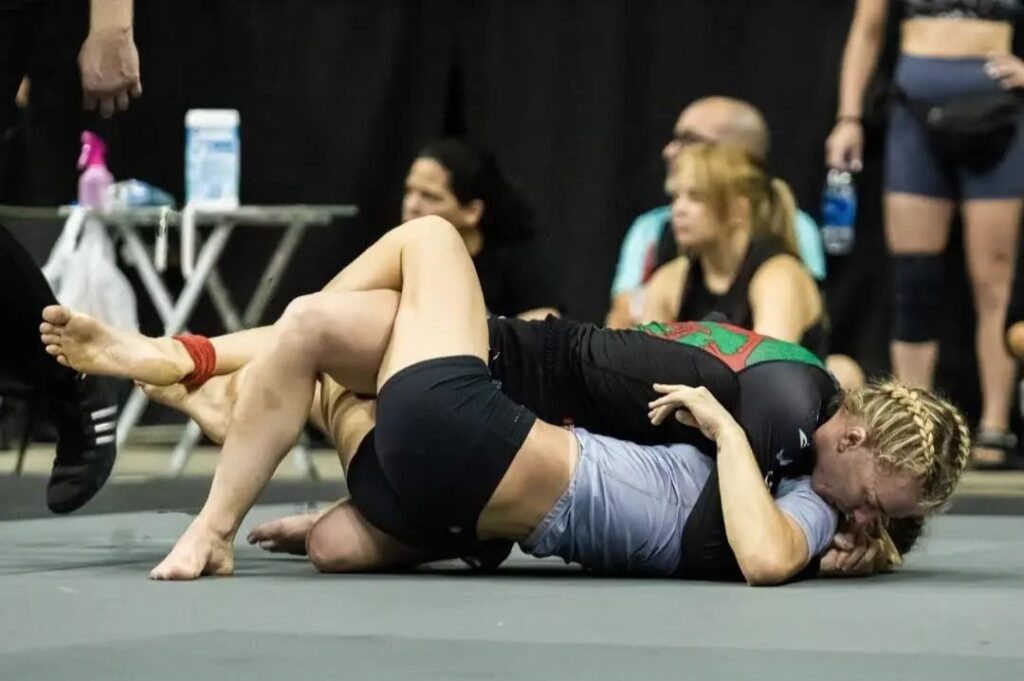Half Guard – BJJ Technique Explained

Half guard has become one of the most innovative positions in all of BJJ. In the beginning of Jiu Jitsu, the position was an afterthought and now it is the core of numerous grappler’s games.
The half guard now has now taken many forms and has shown to have nearly infinite possibilities. You could spend years on half guard and only scratch the surface of what you could do in the position.
This isn’t everything, but just a guide to how to do some of the possible techniques from there. Also give a little detailed history and how some of the forms function.

Contents
How was half guard created
The meia-guarda has been a part of Jiu Jitsu since the martial art was created. Although for nearly a century nobody really practiced techniques from there.
Generally if you had half guard that meant your opponent almost passed your guard and you need to recover. One of the early innovators of practicing half guard techniques was Roberto “Gordo” Correa.
As an 18 year old purple belt under Carlos Gracie Jr. seriously injured his knee and could not play traditional guard. He found himself in half guard frequently and started coming up with ways he could attack from there.
What he came up with would revolutionize Jiu Jitsu and later MMA. A move so simple that is considered an afterthought in modern Jiu Jitsu. The underhook.
By getting an underhook in half guard this allowed Gordo the opportunity to start attacking his opponents. Enabling him to go for back takes, sweeps, and submissions.
By just getting a simple underhook from half guard changed the Jiu Jitsu world. Now people have come up with numerous types of half guards that are continually being innovated.
How does half guard work?
That is a hard question to answer, because there are numerous types of half guard and each have different purposes. Some types of half guard involve you keeping space and others like deep half guard involve getting right under your opponent.
But to try and answer the question all half guards start with proper framing with your hands and legs. These frames prevent your opponent from smashing your back to the mat.
The other detail that many forms of half guard share is getting an underhook. Once you get an underhook on your opponent this control opens the door for you to do many techniques. Everything from back takes, sweeps, submissions, or going under your opponent for deep half guard.
Basic half guard sweep
Here is a basic sweep you can do off an underhook. You start in half guard and you’re making space by framing on your opponent.
When framing this opens space up to take an underhook on your opponent. You could also do a back take, but we’ll detail that later.
Say they block your back take attempt, so you go for a sweep attempt. Slide yourself down under your opponent and clasp your hands together under their rear.
With your inside hand, slide under your opponent and grab their outside foot. Then transfer their foot to your other hand and grab the top of their foot.
Next to finish the sweep, turn your body scissoring their leg, grab their far knee, and drive forward.
Half guard back take
Now for the back take from basic half guard. Start by framing, then swimming your arm in for an underhook. Be sure to hold this underhook across the center of your opponent’s back.
Once you have your opponent, you’re going to shuck them forward and go below them. Then to take their back you unhook your half guard and come out on top in back control.
Knee shield sweep
This is probably the easiest sweep from the knee shield half guard that you could do. Keep your knee up on your opponent’s upper body, while holding wrist control on your knee shield side.
Push the opponent with your knee and naturally they will come back. This is when you do the sweep.
As they come forward, take your knee shield off and place your foot on the mat. Then grab an underhook as you turn your hips taking your opponent to their back.
Deep half guard sweep
Deep half guard is another favorite half guard of many grapplers. The elevator sweep from deep half is one of the most basic and efficient for you to know.
Start the technique by framing on your opponent and then pushing them to make space and get your underhook. As you get your underhook, dive under your opponent, underhooking their, and turning on your other hip.
After you switch your hip, you need to switch your lock to the other side above your opponent’s knee. With your free hand, underhook your opponent’s far leg.
To finish the sweep, pull their leg towards you as you sit up and come out on top.
Z guard sweep
There’s a great z guard in sweep called the rainbow sweep that looks flashy, but it’s really easy to do. Start with your knee shield on your opponent’s chest and hands up to block your opponent’s grips.
You’re going to grab a cross sleeve grip with one hand and the opponent’s knee with the other. Start the sweep by pushing your opponent back to make them come forward.
When they come forward, rotate their arm around your head. This brings your body over your hips.
To complete the sweep, you do a back roll over your shoulder.
Triangle from half guard
A triangle set up from half guard is a pretty common submission to go to. Start from a knee shield and overhook your opponent’s arm and get wrist control on their other arm.
If your opponent gives you pressure this will make getting the triangle easier. As you have their arms controlled, bring your bottom leg out and bring it over your opponent’s arm.
Clamping down on their and then all you do is lock in your triangle choke.
Kimura from half guard
Going for a half guard is a great idea from the bottom half guard. You can either try to submit your opponent or use the grip to sweep them.
With a knee shield and your arms, use them to push your opponent to the side. Forcing them to base on the mat with their hand.
Once they base on the mat, quickly bring your chest over their arm and grab a kimura grip. Then extend your back to make space and put their arm behind their back.
Kneebar from half guard bottom
Another submission option from the bottom half guard you can go for is a kneebar. Just like many of the submissions and sweeps from the position it comes from the initial bumping of your opponent.
With your knee shield and frames, you’re going to push your important to make them push back. As they come back it gives you an opening to hook their leg.
Rotate your legs around their leg and then use your opponent’s energy to take them over into the kneebar.
Tips for playing half guard
While there are many different types of half guards and even more techniques, they all share common details. Here are some tips.
- Framing: No matter what your objective is in half guard, you must start with proper framing. You have to block your opponent cross facing or controlling your body and force you on your back. Keep your hands and knees up to prevent this.
- Sit-Up: To play half guard you must be sitting up and ready to attack. Being on your back isn’t half guard. Just a guard your opponent has completely passed yet.
- Underhook: The underhook is one of the most important details when playing a half guard. It provides control over your opponent and allows you to go into your technique.
- Head Placement: Keep your head down and under your opponent’s chin. If you keep your head up too high your opponent can use it to control you.
- Don’t just hold: You can’t just hold onto your opponent and wait for something to happen. You have to move and make something happen.
- Active Legs: Your legs need to stay active, otherwise your opponent will pass with ease.
- Knee Placement: If you’re playing knee shield or Z guard, your knee placement is important. Keep it at an angle on your opponent’s chest to enable yourself to keep space and be able to move.
- Transition: Remember that you can also transition to other positions out of half guard. Full guard, x guard, butterfly guard, etc.






